Vanillekipferl are vanilla crescent cookies filled with nuts and dusted in a generous coating of vanilla sugar. A popular European treat, these delicate cookies are perfect for holiday cookie trays.
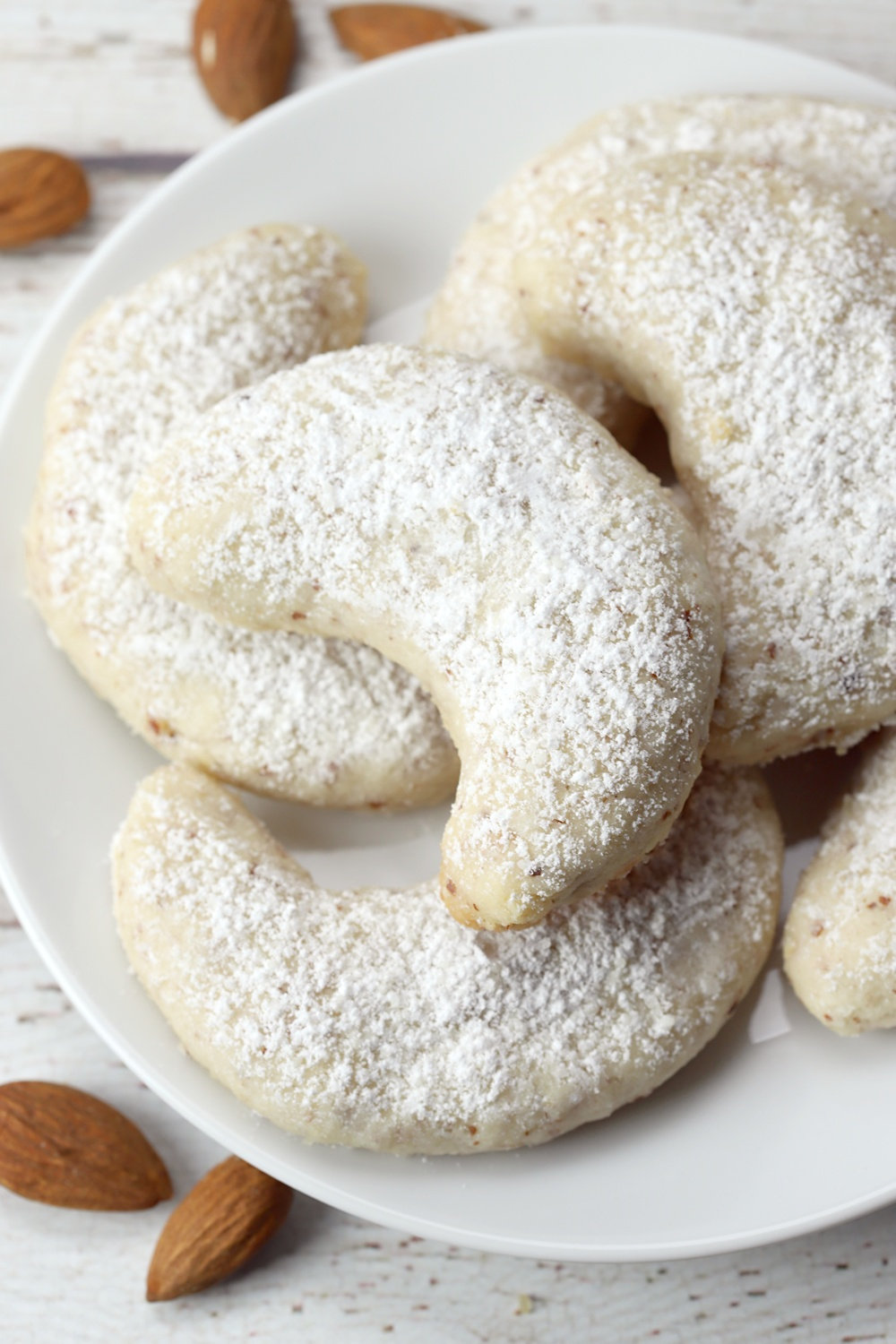
Vanillekipferl are crescent shaped cookies, popular in Austria, Germany, Hungary, Poland, Czech Republic, Romania, and Slovakia. Their signature taste comes from vanilla sugar, a common baking ingredient in Europe.
While vanilla sugar is not common in the United States, it is easy to find online. I also have a few simple ways to make your own at home!
Vanillekipferl remind me of a shortbread cookie, with the addition of ground nuts. They are tender and buttery, with added texture of ground almonds.
Ingredients and substitutions
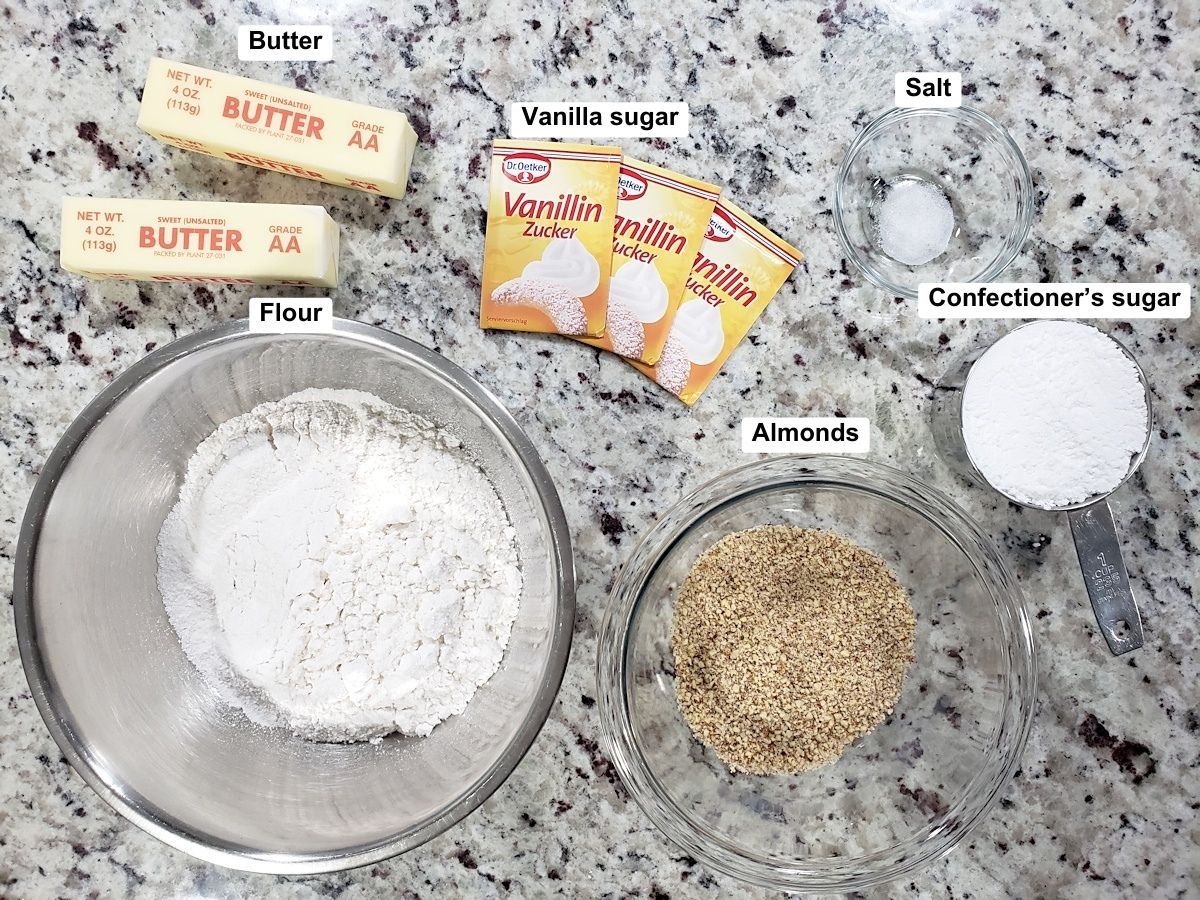
- Unsalted butter - Can be substituted with salted butter if needed (you'll also want to omit the listed salt).
- All-purpose flour - Adds structure to your cookies. I have not tested this recipe with other types of flours, so I can't say how your cookies would turn out by making flour substitutions. If you don't have all-purpose flour on hand, I recommend searching for a recipe that can be made without substitutions for best success.
- Ground almonds - Can be substituted with almond flour or other ground nuts, like walnuts, hazelnuts, or pecans.
- Confectioner's sugar - I use confectioner's sugar in this dough because it's slightly easier to work with in a shortbread type dough when compared to granulated sugar. It also gives the cookies a tender, soft texture when baked. You'll also need a bit of confectioner's sugar for dusting on top.
- Vanilla sugar - This ingredient can be omitted if you don't have any on hand. I've also included instructions on how to make vanilla sugar below (and in the recipe card) if you'd like to make your own.
- Salt - Enhances the flavor of your cookies without making them "salty".
How to make ground almonds
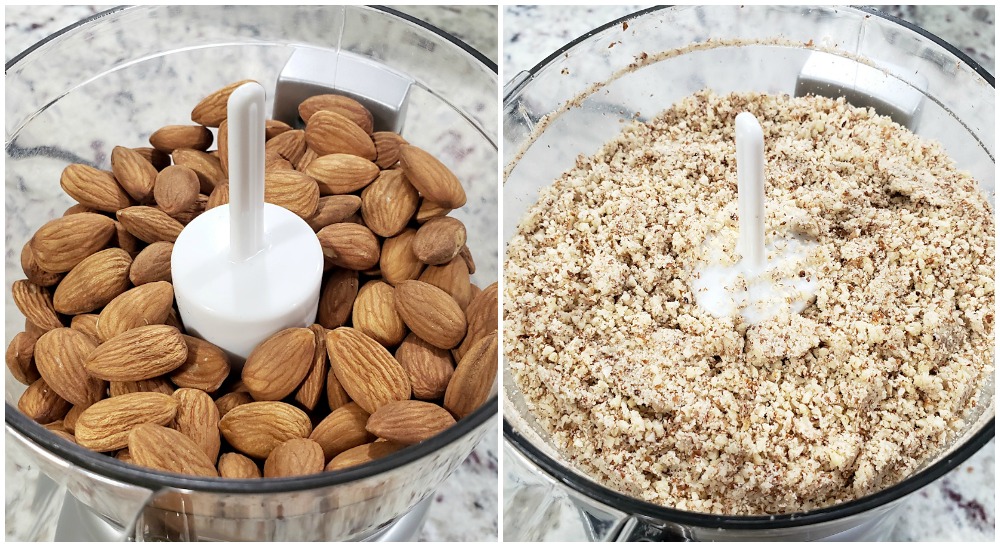
If you don't have ground almonds on hand, it is easy to make your own with whole, raw almonds.
Add your almonds to a food processor, then pulse until you have a coarse meal.
You can use this method for any type of nuts. Be careful not to blend your nuts too much - this is how you make almond butter.
How to make vanilla sugar
Vanilla sugar is a common baking ingredient in Europe, and widely available in stores overseas. However, it is uncommon in the United States.
I found these packets of vanillinzucker on Amazon, which worked perfectly. Keep in mind that vanillezucker is made with real vanilla and vanillinzucker is made with artificial vanilla.
If you'd like to make your own, I recommend checking out this post by The Kitchen Maus: Vanilla Sugar. She compares several types of vanilla sugar and shows you how to make your own using vanilla beans.
You can also make vanilla sugar using vanilla extract. In a food processor, combine ¼ cup of granulated sugar with ½ teaspoon of vanilla extract.
Spread it out to dry. Once dried, the sugar will be clumpy. Transfer back to the food processor and pulse until you have a sugar consistency again.
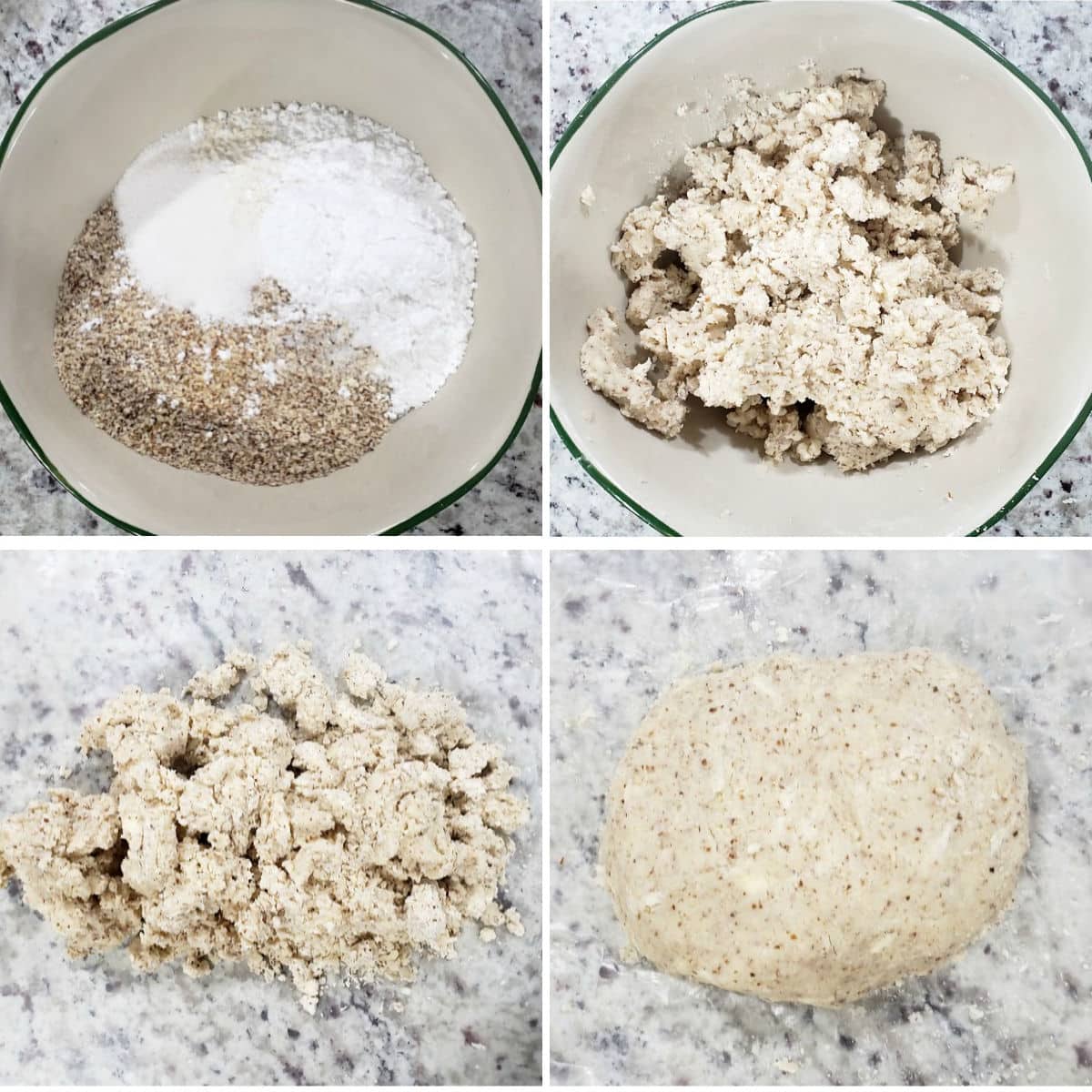
Tips for baking cookies
For my full list of tips and tricks for making a perfect batch of cookies, check out my post: 10 tips for baking cookies
- Measure flour correctly - The number one issue I see consistently in baking is the mismeasuring of flour. Adding too much flour to a baking recipe will make the dough turn out crumbly and dry, with a diluted flavor. While this crescent cookie dough is a little crumbly (it is a tender, buttery cookie much like a shortbread cookie), it will come together with a little shaping. To properly measure flour, I highly recommend using a kitchen scale. If you don't have a kitchen scale, gently stir your flour with a spoon, then spoon the flour into your measuring cup and level off the top with a knife. Scooping flour directly from a bin with your cup compacts the flour into the cup, adding up to 25% extra flour to the recipe.
- Chill your dough - The step of chilling your dough should not be skipped for several reasons. Chilling the dough helps the flavors to meld, but it also helps your dough firm up, making it easier to manipulate and roll into balls. Chilled dough also spreads less in the oven.
- Keep an eye on your cookies in the oven - Baking times in any recipe are recommendations based on the writer's own experience, and can vary greatly based on your own oven settings. Ovens can run hotter or colder than the next, even when set to the same temperature. I recommend keeping an eye on your cookies instead of the time, and take them out when they look done.
- Don't grease your baking sheets - Adding a layer of grease to a baking sheet causes cookies to spread more in the oven while they bake. Instead, I recommend using parchment paper or a silicone baking mat.
Shaping dough into crescents
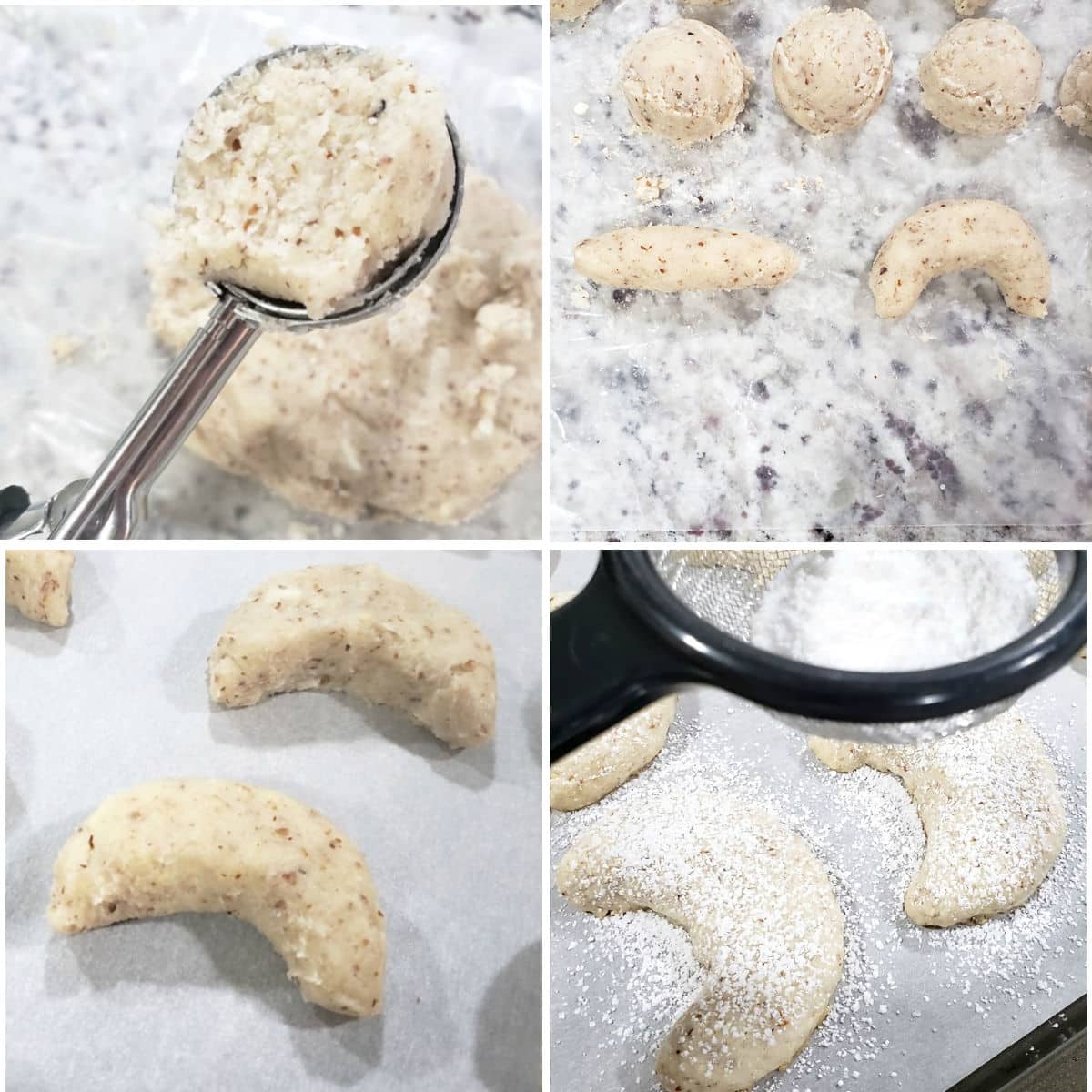
For consistent shape and size, I recommend using a medium cookie scoop to portion out your dough, which is 1.5 tablespoons. While not required (the dough can be rolled by hand), this ensures your cookies all turn out the exact same size.
Roll the ball of dough between your hands to make a log, lay onto your baking sheet, then gently turn the ends into a crescent shape.
Be careful - the more you handle the dough, the softer and stickier it becomes. The warmer the dough, the more it will spread when baking. If needed, return your dough to the refrigerator until it firms up again.
Just out of the oven, dust the top of each cookie with a generous layer of dusting sugar. The initial layer may melt slightly, so feel free to dust each cookie twice.
I used a mini strainer to dust my cookies, but there are plenty of fun dusting wands made especially made for this task.
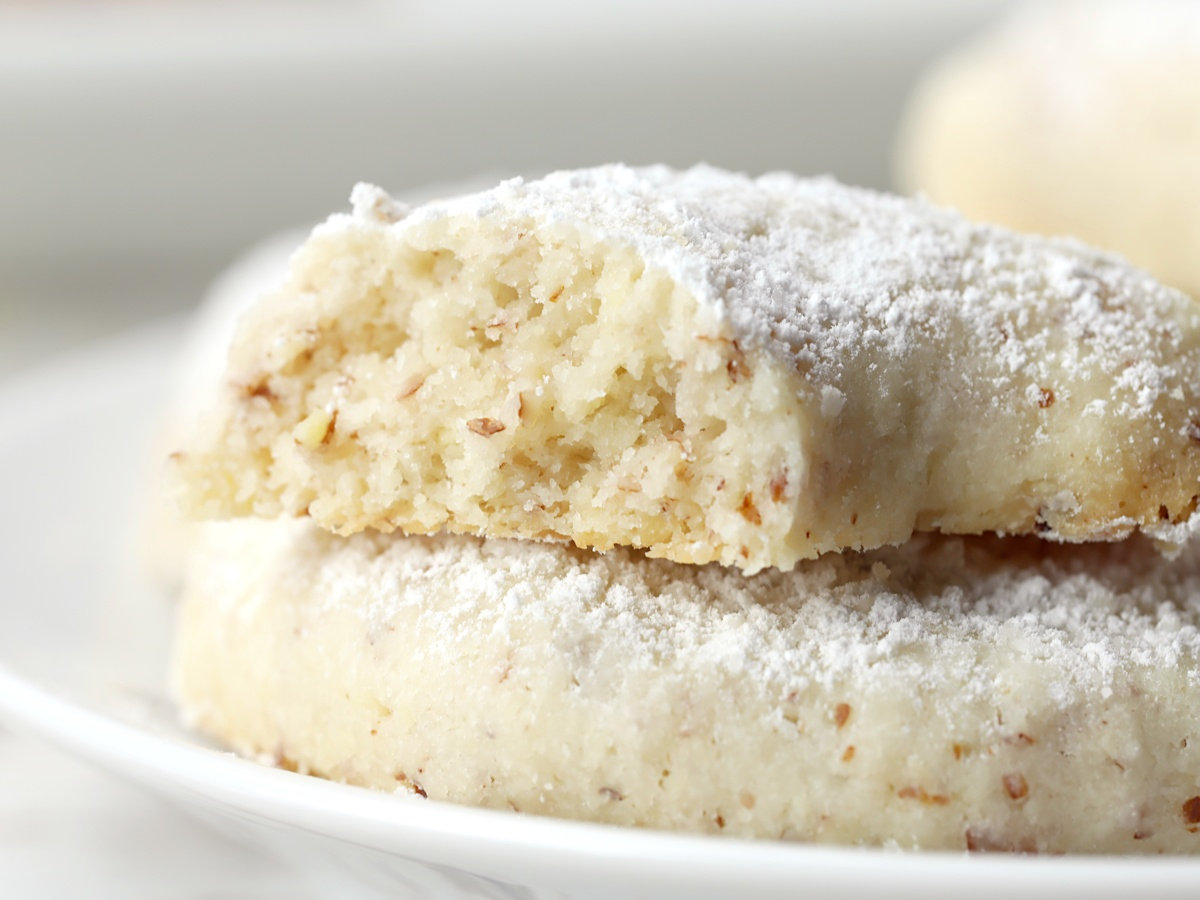
Storage and freezing
Leftover crescent cookies will keep for up to 5 days in a tightly sealed container at room temperature. Homemade cookies begin to dry out after about two days, so I recommend adding a slice of bread to your cookie container. The bread dries out instead of the cookies, helping keep them fresh for longer.
Baked cookies can also be frozen for three months or more in a tightly sealed container in the refrigerator. To thaw, place on the countertop for an hour or more.
Recommended
📖 Recipe
Vanillekipferl - Vanilla Crescent Cookies
Ingredients
Cookies
- 1 cup (226 g) unsalted butter, cold
- 2 cups (240 g) all-purpose flour
- 1 cup (96 g) ground almonds
- ½ cup (57 g) confectioner's sugar
- 1 tablespoon (12 g) vanilla sugar, *
- ⅛ teaspoon salt
Dusting sugar
- ⅓ cup (38 g) confectioner's sugar
- 1 ½ teaspoons (6 g) vanilla sugar, *
Instructions
Cookies
- Slice cold butter into cubes. In a food processor, add flour and cubed butter. Pulse until butter is the size of small peas. Alternately, use a fork or pastry blender to incorporate butter into flour.
- Add the remaining ingredients to your flour mixture - ground almonds, confectioner's sugar, vanilla sugar, and salt. Mix until combined. Dough should be crumbly, but hold together when pinched between two fingers. If you're having trouble getting your dough to come together, add up to a tablespoon of water and mix until a dough forms.
- Toss dough out onto wax paper or parchment. Form into a disc, wrap, and refrigerate for one hour (or up to 24 hours).
- Preheat oven to 350 degrees Fahrenheit and line a baking sheet with parchment paper.
- Scoop dough using a medium cookie scoop (1.5 tablespoons) and shape into a crescents with your hands. Work quickly - your hands will warm the dough, so try to handle as little as possible.
- Place crescents 2 inches apart on a lined baking sheet. Bake for about 12-14 minutes, or until edges are lightly browned.
Dusting sugar
- Meanwhile, combine confectioner's sugar and vanilla sugar in a small bowl.
- Immediately upon removing cookies from the oven, top each cookie generously with prepared dusting sugar.
- Transfer to a cooling rack and allow to cool completely before storing.
Equipment Recommendations
Notes
- *If you do not have vanilla sugar on hand, it can be purchased on Amazon, or you can make your own using vanilla extract.
- How to make vanilla sugar: In a food processor, combine ¼ cup of granulated sugar with ½ teaspoon of vanilla extract. Spread it out to dry. Once dried, the sugar will be clumpy. Transfer back to the food processor and pulse until you have a sugar consistency again.
- One packet of vanillezucker/vanillinzucker contains about 1.5 teaspoons of vanilla sugar. To make 24 cookies with this recipe, you will need 3 packets of vanilla sugar, or 4.5 teaspoons.
- Almonds can be substituted with walnuts or hazelnuts.
- Be sure to check out my 10 tips for baking cookies, based on reader comments and questions!

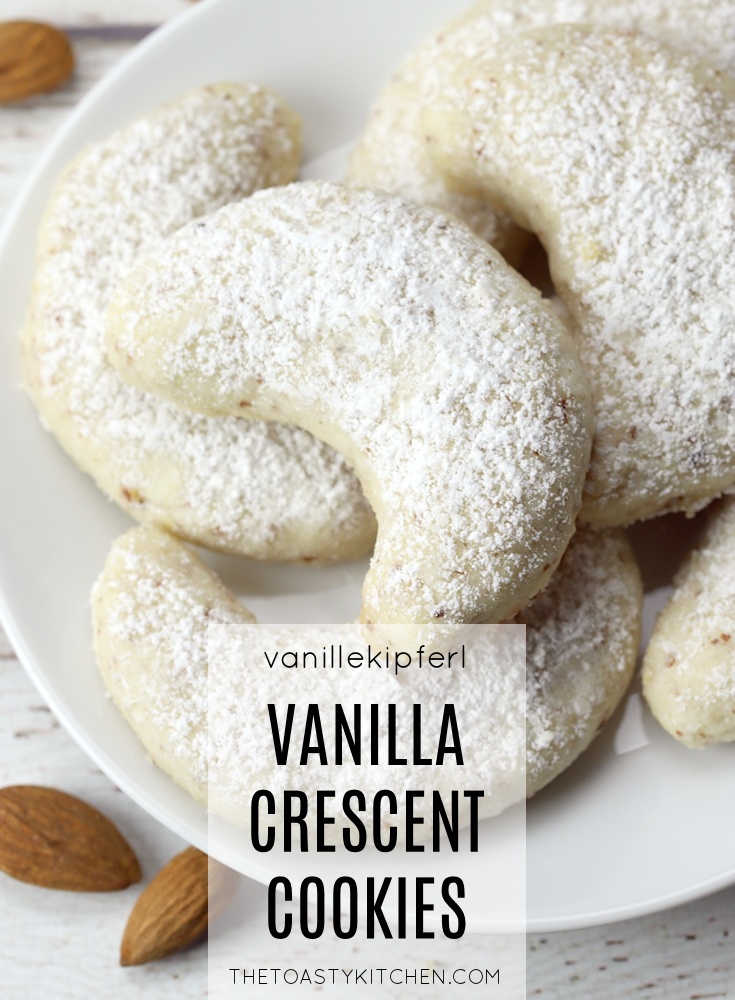
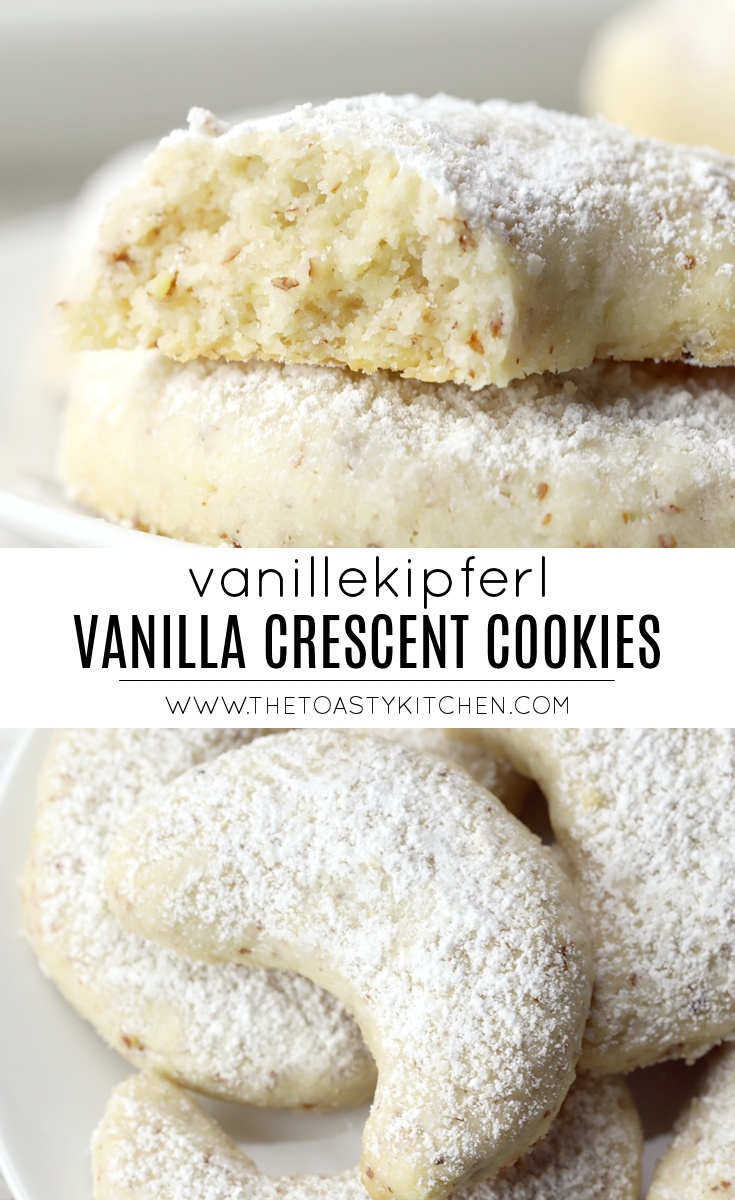
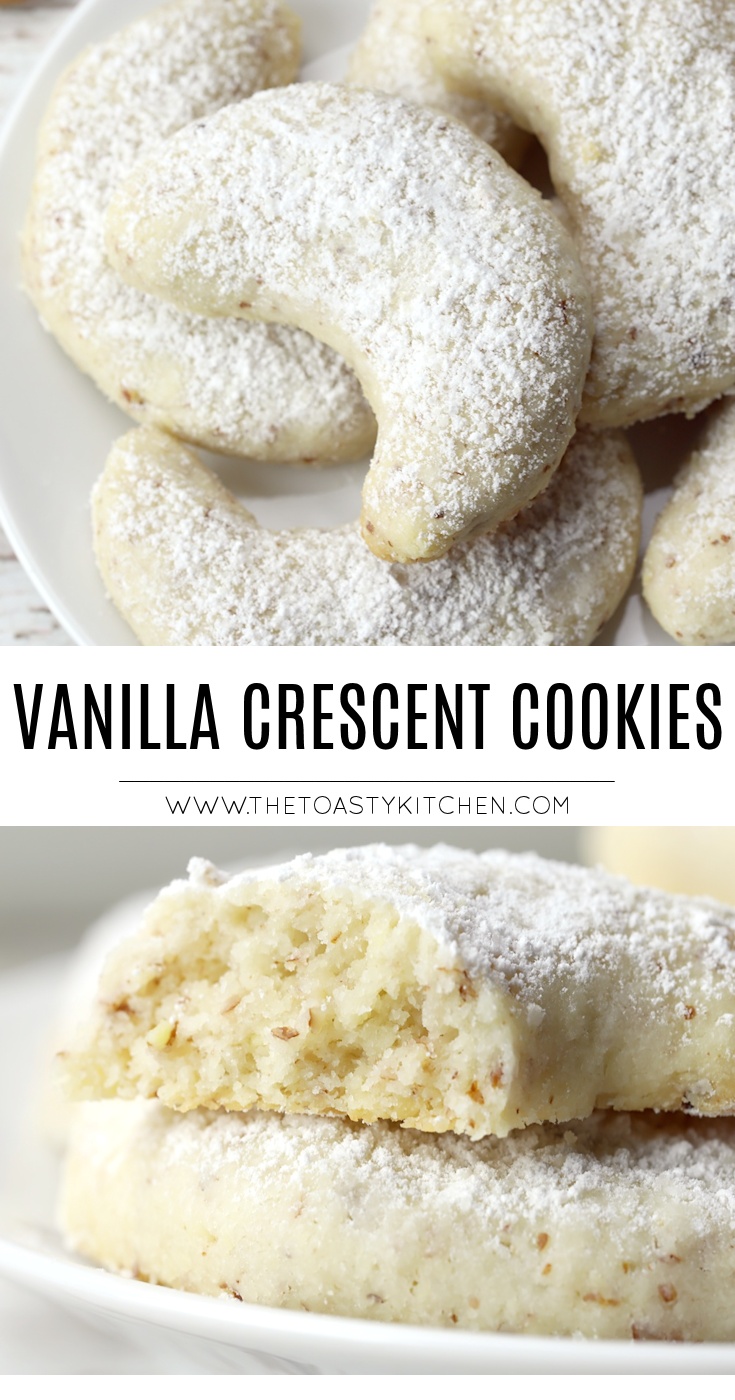
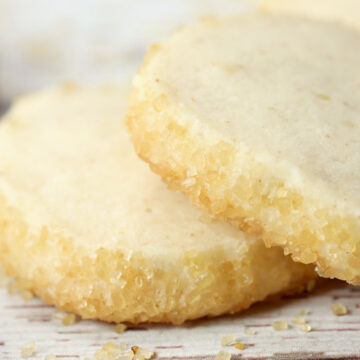
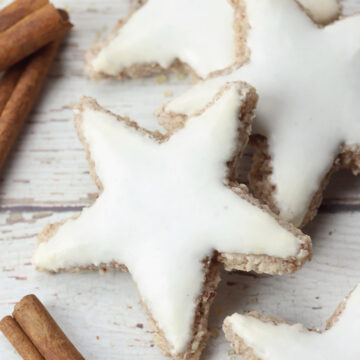
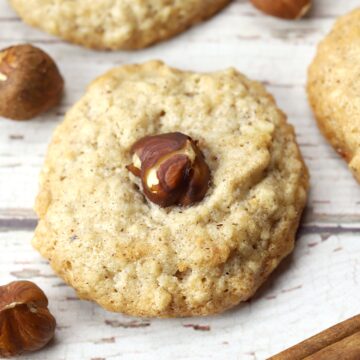

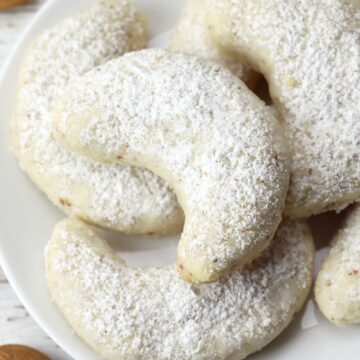
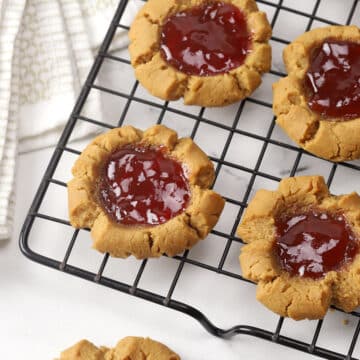
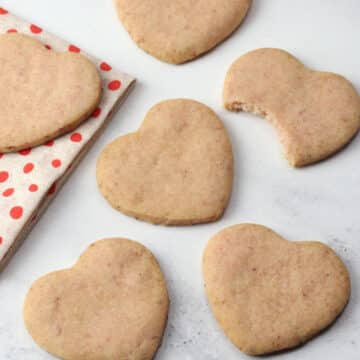


The cookies were absolutely 5-star cookies, and I thank you for excellent ingredients and clear writing. The method, as written, didn’t work for this non-food-processor user, in Canadian winter.
Here’s why: using my pastry cutter until the cold butter was small-pea-sized, in my draughty 17C/62F kitchen, and then mixing in the other ingredients with my wooden stirring paddle, left me with crumbly, dry stuff that resembled fine, sandy river-shore gravel, more than dough.
Being an experienced pastry maker, I knew that a tablespoon of water would not be enough, but if I used enough water to get the dough to stick together, the cookies’ delicate texture would be lost.
What I did was put the dough in the microwave, on low power (30%) for ten seconds at a time, checking temperature & texture after each 10 seconds. After 2 turns, it was soft enough. I gently folded the dough a few times, briefly pressing it flat with cold hands, to form that disk. It worked! I then rested the dough at room temperature for about an hour. When I came back to it, I formed my crescents, & baked, according to the recipe.
I put my homemade vanilla sugar in a spice grinder, until it was a fine powder. I whisked about a quarter cup of the vanilla powder into 2/3 cup confectioners’ sugar.
Setup for dusting the cookies: I had a pie dish with 1/2 of the sugar mix ready. Beside this I placed a rack, under which I had spread waxed paper. I placed a small sieve in the bowlful of sugar-mix on the other side of the rack.
Immediately on taking the cookies from the oven, I transferred them via spatula, three at a time, into the pie plate full of sugars. I shook the plate a little, to ensure their bottoms were sugared. Working quickly, I plucked them up and onto the rack. I then sprinkled them with sugar from the sieve. I repeated this until all the cookies were sugared. As I came to the end of the dozen on the cookie sheet, I had to put them back into the still-hot oven for a few minutes. If the cookies cool, the powder won’t stick.
I made these as a gift for a European friend. I can’t eat wheat, so I gave a cookie to my sweetheart to try. He said they were delicate in texture, deliciously subtle with ground hazelnuts and butter, and very, very good. Thank you for helping make my friend happy!
There is a significant difference between your US Customary Measurements and the Metric for the Vanilla Crescent cookies. I thought it looked like it had too much butter and it has. Two cups of spooned flour is 285 grams of flour not 240 grams. I haven't checked the other measurements but I suspect they are way off too.
So I have a double batch that are mostly butter that I am waiting to get soft so I can add additional flour. While that is happening I will make another batch for the Christmas party tonight..
No one has complained because no one has checked.
Hi John, I just doubled checked the measurements for this recipe and everything is correct. We follow King Arthur Flour's measurements for flour (https://www.kingarthurbaking.com/learn/ingredient-weight-chart), which is 120 grams per cup of flour. We weigh our ingredients with a scale, and these are the measurements we used to make the recipe. One stick (1/2 cup) of butter is 113 grams, which is the measurement labeled on each stick of butter, for 226 grams total (you can see the measurements printed on the labels in the ingredient photo above).
Hello, I made these a couple weeks ago and they were very good. Similar to so many of the pecan crescents we have make every year at Christmas. This one was a nice slight change. A keeper. TU Pat
Can the dough be made ahead and frozen?
Yes, cookie dough can be frozen for up to 3 months!
I have a question. Can I use almond meal or the other nut meals that are available?
Hi Judy, yes you can! Walnuts and hazelnuts are also a great choice.